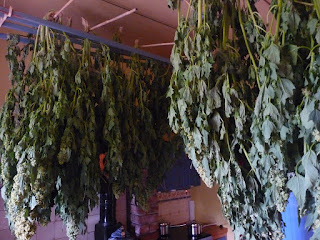 |
| Gets on well with the local wildlife |
We're always interested in how we can push back the limits of our self-sufficiency, within the bounds of reasonability. Grains are a prime example: Sure, we could grow some oats, barley or even wheat. It's the processing of them on such a small, manual scale where the idea hits the buffers of reasonableness. Threshing and winnowing would simply take far too much time and effort for the return.
The suggestion that extracting the edible parts of quinoa could be feasible on our scale held out the hope that maybe we could produce some of our own grain. Not only that, but the plants are not unduly bothered by the pests present in our part of the world and the grains themselves are coated with a soapy protective layer (which has to be soaked away before culinary use), rendering them unpalatable to birds, rodents and such like.
We bought some seeds and gave it a go. Here are our observations at the end of the first season.
 |
| Cut and ready for wilting |
Getting along into September, we could see the grains forming in the flowers and start to release them with a gentle rub between the palms. Slight nervousness about the approaching equinoctial gales prompted us to harvest them at that time, which was probably a mistake. We should have held our nerve and left them until late September or early October and we'd likely have had a much better yield.
 |
| Ducking under these all the time was not ideal |
 |
| At the threshing station |
Threshing and winnowing by hand is pretty straightforward. It really is just a matter of rubbing the flower heads between your palms, over a bucket and then gently blowing away the chaff.
As you can see in the photo, a quarter-inch riddle or similar is a help in screening out the larger debris.
 |
| Loads! Right...? |
We passed a very pleasant afternoon at the threshing and winnowing and when we were finished it looked like a pretty respectable quantity.
Two or three days later, after it had dried down completely, the yield looked less impressive. 500g was what we ended up with.
Will we try it again? I'm going to say yes, we'll give it one more go and hold out for a later harvest, which ought to at least double the yield. The prize of a home-grown nutritious grain deserves another chance.
I had heard about the quinoa allegations, but was unaware they had been debunked! Glad to hear it! Glad you're persevering with quinoa, would be so great if it could work on your scale!
ReplyDelete